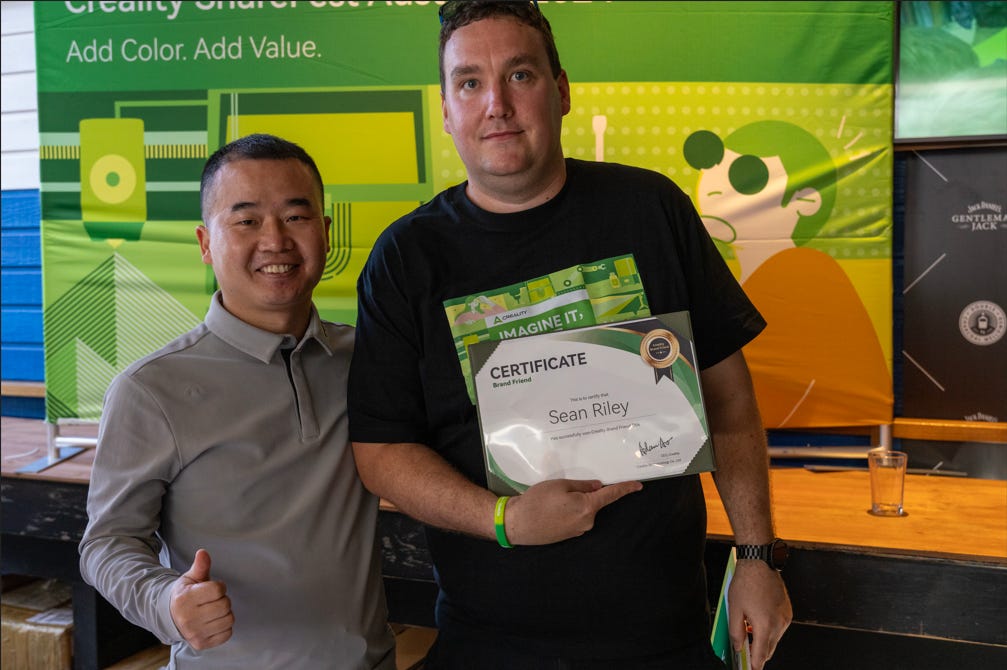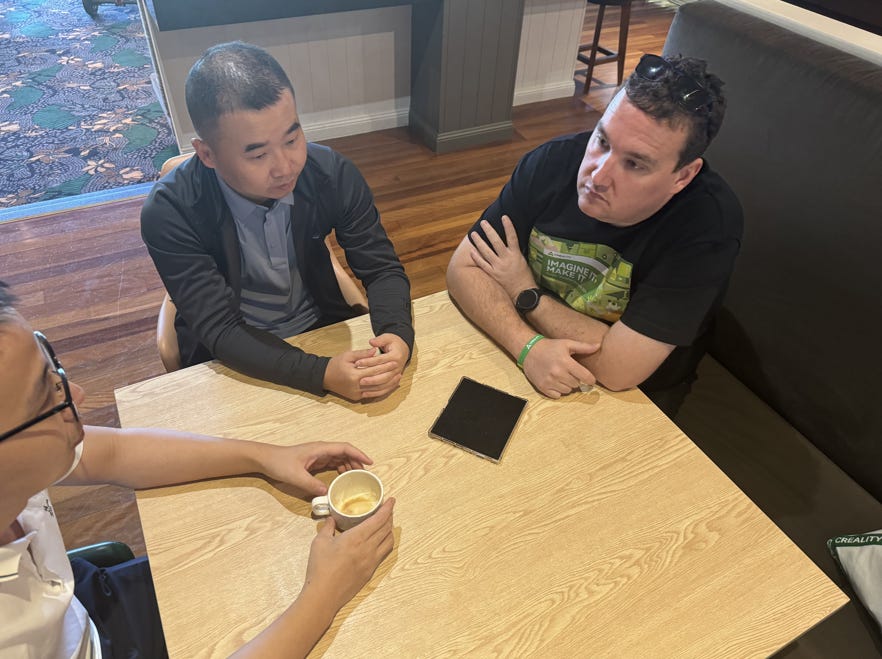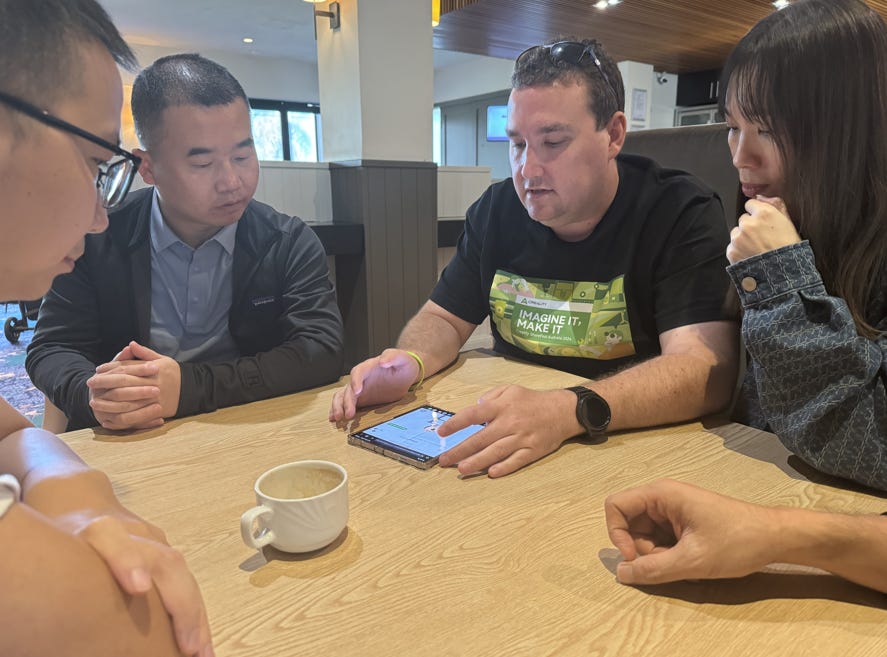Background
Back in September I had the privilege of attending and helping to host the Creality Sharefest on the Gold Coast.
It was an incredible event attended by over 70 people including staff from China who came over to help host the 3 sharefests throughout Australia in the month of September. However the Gold Coast event was unique as the CEO of Creality had made the trip over too, the reason for this being that Jaycar, one of Crealitys biggest customer in Australia was hosting their annual sales conference the following week on the Gold Coast with Mr Ao set to attend as a special guest.
First impressions.
During the event I had the chance to get to know Mr Ao. Once we started talking I could tell immediatly that he had a deep knowledge of 3d Printing and its history which surprised me at first. However, the reason for his knowledge and I didn't know this initially was that Adun Ao was one of the original 4 members who started Creality over 10 years ago. It became clear to me that Creality was more than just a passion project for him and I was impressed at how invested he still was in Creality. Throughout my career I have had chats with CEO's and Directors in other industries who are not as heavily invested in the products they make but instead just focus on keeping their business alive.

After my initial talk with Mr Ao I asked one of the other Creality staff if I could arrange to interview Adun to discuss the Australian market and bring up some issues I had seen with Creality in the past. Given that all our talks had to be via translator and with me leaving the next morning I wasn’t so sure this would be possible or if Mr Ao would be interested but figured no harm in trying. We wrapped up sharefest on the saturday night and exhausted I went off to my hotel room to collapse but just before falling asleep I was informed that Mr Ao would make time for me the next morning after breakfast before he his entourage would head out to check out some Jaycar stores.
The interview.
The interview was informal and not recorded which did not bother me. Anyone who knows me knows that I do not hold back when sharing an opinion. I have not always been a fan of Creality's, I may run their facebook group in Australia but back then that was just because they were the first company to actually focus on Australia and not ignore us Aussies like most other 3d printing companies do. Over the past year however I have made my way back to Creality and now use most of their products on a weekly basis.

The thing that surprised me the most throughout the interview was how many questions he himself asked. He didn't just listen or give the idea he was listening, he actually engaged with me asking me to explain more or asking me to provide evidence of my claims which I then attempted to provide. Throughout the hour of talking with many translations back and forward I believe I was able to communicate some of the pain points that users in Australia and maybe even around the world have with Creality and the industry as a whole.

Given that the interview was not recorded I asked if I could submit some questions to Mr Ao for him to answer and he agreed to this. Below I will share the english translation of the answers given to me from those questions. The questions have been edited a bit to allow for easier translation to Chinese.
The future.
While I do not know if what I brought to Mr Ao's attention will bring about change inside Creality I continue to be optimistic for the future of 3d printing both with Creality and the 3d printing industry as a whole. I am also thankful for being given the opportunity to bring the voices of Australian users to both Creality and Mr Ao and look forward to more companies taking notice of the potential opportunities Australia provides.
### Interview with Creality’s CEO: Exploring the Future of 3D Printing ###
**Sean** Can you share the founding vision behind Creality?
** Mr Ao:** Certainly. During my time at university, I followed tech news closely, and 3D printers left a deep impression on me. I realized that this technology represented the future and had the potential to significantly impact people’s lives. At that time, our graduation projects were mostly done by hand, and many complex ideas were difficult to execute. 3D printing offered a solution to that. I saw its immense potential. However, most 3D printers on the market were industrial-grade and very expensive. I wondered if we could bring this technology to the consumer market at a more affordable price—could it trigger a new tech revolution? Coincidentally, a few of my partners had the same idea. We all believed there was a vast market for consumer-grade 3D printers.
**Sean** How did you view 3D printing technology back then?
**Mr Ao:** In the early days, 3D printers were primarily used by makers and DIY enthusiasts, with a focus on speed, stability, and efficiency. But I always felt that 3D printing shouldn’t be limited to just that—it should be a more versatile tool that can integrate into everyday life. For example, in fields like healthcare, film production, architectural design, and even fashion, 3D printing can bring ideas to life. The technology has the power to unleash creativity and make 3D printing a trend that could one day be found in every household.
**Sean**What are your market strategies moving forward?
** Mr Ao :** We have always emphasized the importance of "localization" and diving deep into each market. Our goal is to tailor our products to meet the specific needs of users. Moving forward, we plan to segment our products based on different application scenarios, such as machines focused on footwear, dentistry, or even food printing. 3D printing technology is still in its early stages, and many people don’t fully understand its potential. But I believe that in the next five years, this market will grow rapidly, and the technology will continue to advance.
**Sean** What technical breakthroughs can we expect in the future?
** Mr Ao:** In the short term, we are focusing on multi-color printing and high-speed printing, aiming to achieve speeds of up to 1,500 mm per second. We are also working on multi-material printing, which will further expand the applications of 3D printing. In the future, there are two paths for the development of 3D printing: one towards portable, smart, and home-based devices, and the other towards solving real-world problems, such as food printing, home design, and integrating with other industries through distributed manufacturing. Looking even further ahead, we might see 4D printing—a new class of materials that could bring revolutionary changes. In short, our technology will always evolve with the needs of users and the market.
**Sean**You mentioned "distributed manufacturing." Could you elaborate on that?
** Mr Ao:** Yes, this means that 3D printing will not rely solely on centralized factory production but can be done locally, even in homes. This not only improves efficiency but also greatly reduces waste, making it more environmentally friendly and energy-efficient. Our company is actively exploring low-carbon, eco-friendly technologies, aiming to contribute more value to society.
**Sean** What’s the secret to Creality’s success?
** Mr Ao:** I think the key is "openness." We maintain close contact with our users, who provide us with valuable feedback and suggestions. Through this interaction, we continuously improve our products and enhance the user experience. Of course, our investment in technology is also a driving force behind our progress. Even though our after-sales service is already leading the industry, we are always striving to do better—faster, more localized, and more efficient.
**Sean** What are your thoughts on the Australian market?
** Mr Ao:** I’m deeply impressed by Australian 3D printing enthusiasts. They are very passionate, spanning a wide age range—from young people to older adults, all with the same love for 3D printing. Although this is my first time in Australia, it feels like reconnecting with old friends. The support and feedback from the community always moves me. Moreover, Australians are incredibly efficient, serious, and friendly. The Gold Coast, in particular, is stunning, with its beautiful scenery and pleasant climate—it’s truly an ideal place to live.
**Sean**What is Creality’s vision for the future?
** Mr Ao:** Creality has not only created success for ourselves but also for many of our partners, whether they are employees or distributors. We are committed to fostering the development of the entire industry. Looking ahead, we hope to work with even more partners to advance 3D printing technology and share the value it brings. We believe the future of 3D printing will be even brighter, because as we like to say internally: “If you can imagine it, you can create it.” This is what drives us: we believe, so we can see.
